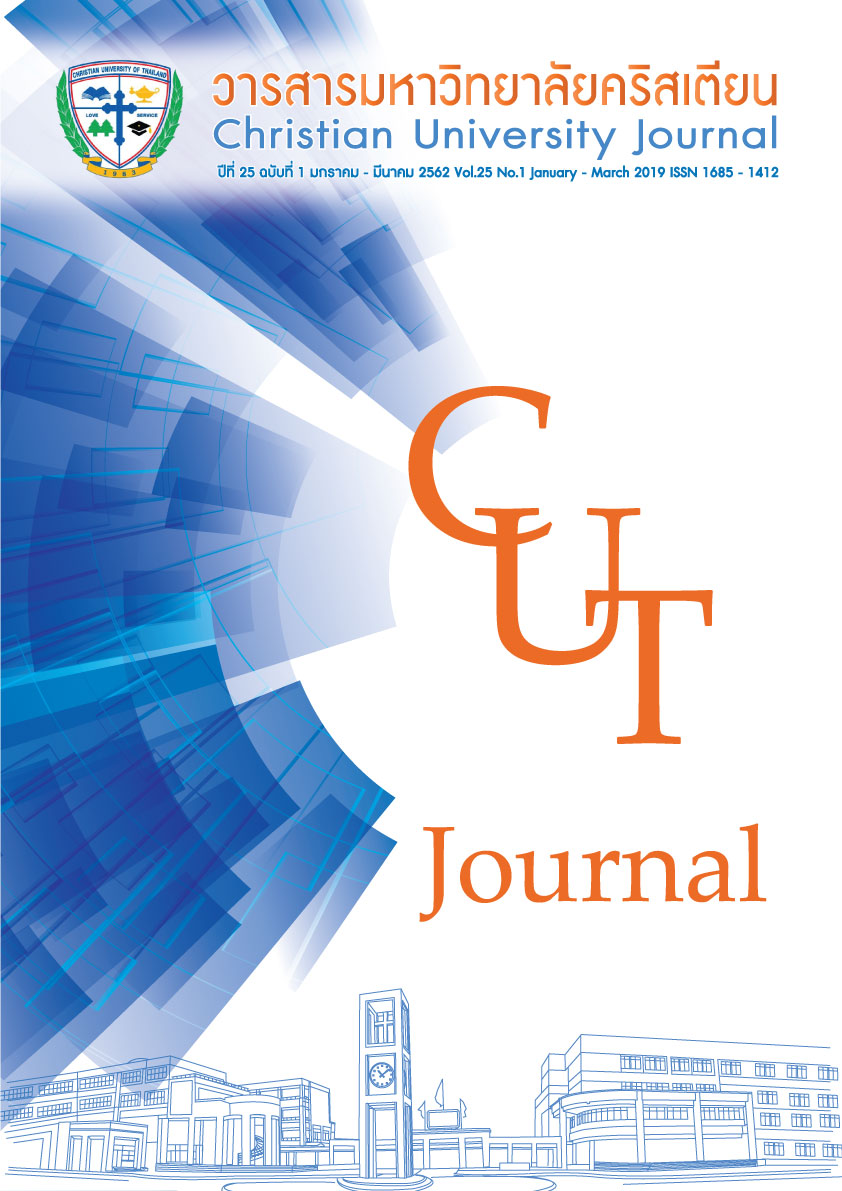การพัฒนาโปรแกรมการสื่อสารโดยมีชุมชนเป็นฐานสำหรับการป้องกัน และควบคุมโรคติดต่อจากสัตว์สู่คน
คำสำคัญ:
โปรแกรมการสื่อสารโดยมีชุมชนเป็นฐาน, การป้องกันและควบคุมโรคติดต่อจากสัตว์สู่คนบทคัดย่อ
การวิจัยเชิงพัฒนานี้มีวัตถุประสงค์เพื่อพัฒนาโปรแกรมสำหรับการป้องกันและควบคุมโรคติดต่อจากสัตว์สู่คนตามแนวคิดการสื่อสารเพื่อการพัฒนา โปรแกรมได้พัฒนานี้มีระยะเวลา.5.วัน กระบวนการพัฒนาถูกแบ่งออกเป็น 2 ขั้นตอน คือ ขั้นตอนที่ 1 เป็นระยะเวลา 3 วันสำหรับการให้ข้อมูล และขั้นตอนที่ 2 เป็นระยะเวลา 2 วันสำหรับการลงมือปฏิบัติ ในขั้นตอนที่ 1 มีผู้ให้ข้อมูลทั้งหมดจำนวน 18 ราย ซึ่งประกอบด้วยอาจารย์จากมหาวิทยาลัยเชียงใหม่จำนวน 16 ราย นักสาธารณสุข 1 ราย และพยาบาลจากเทศบาลตำบลหนองควาย 1 ราย และในขั้นตอนที่ 2 มีผู้แทนชุมชนจากเทศบาลตำบลหนองควายทั้งหมดจำนวน 30 ราย การทดสอบคุณภาพด้านความตรงของเนื้อหาเกี่ยวกับการป้องกันและควบคุมโรคติดต่อจากสัตว์สู่คนโดยผู้ทรงคุณวุฒิจำนวน 5 ท่านได้ค่าดัชนีความตรงของเนื้อหาเท่ากับ 1 การประเมินประสิทธิภาพของสื่อที่พัฒนาขึ้นแบบกลุ่มภาคสนาม วิเคราะห์ข้อมูลโดยใช้สถิติเชิงพรรณนา
โปรแกรมการสื่อสารโดยมีชุมชนเป็นฐานสำหรับการป้องกันและควบคุมโรคติดต่อจากสัตว์สู่คนได้รับการพัฒนาขึ้น สื่อที่ใช้ในประชาสัมพันธ์ที่ได้รับการพัฒนาระหว่างการวิจัยด้วยมี โปสเตอร์ เพลงพื้นเมืองล้านนา สโลแกน ข้อความโฆษณาทางวิทยุสั้นๆ และเพลงพื้นบ้าน การวิจัยชี้ให้เห็นว่าโปรแกรมและสื่อที่ใช้ในประชาสัมพันธ์นี้มีความเหมาะสมที่จะใช้ในการป้องกันและควบคุมการแพร่กระจายของโรคติดต่อจากสัตว์สู่คนได้ในชุมชนภาคเหนือตอนบนของประเทศไทย
เอกสารอ้างอิง
Agromisia. (2008). How to prevent occurrence of zoonotic diseases. Retrieved November 23, 2018 , from http://www.infonet-biovision.org.
Clark, H., Lake, A., Bokava, I., Chan, M., Diouf, J, Sidibe, M, & Somavia, J. (2011). Communication for development: Strenthening the effectiveness of the United Nations. Retrieved November 9,2016 , from http://www.unicef.org.
David, K.F. (2011). Getting the Slogan Right. Journal Academic Librarianship, (37) ,195-196.
Huong, V.T.L., Ha, N., Huy, N.T., Horby, P., Nghia, H.D.T., Dinh, V., …Hiramaya, K. (2014). Epidemiology, clinical manifestations, and outcomes of Streptococcus suis Infection in humans. Emerging Infectious Diseases, (20), 1105-1114.
Ke, Q., & Wang, W. (2013). The Adjective Frequency in Advertising English Slogans. Theory Practice Language Studies, 32(2), 275-284.
Lim, L., & Kwok, Y.L. (2015). Evaluating slogan translation from the readers’ perspective: A case study of Macao. Babel, (61), 208-303.
Navacharoen, N., Chantharochavong, V., Hanprasertpong, C., Kangsanarak J, & Lekagul, S.(2009). Hearing and vestibular loss in Streptococcus suis infection from swine and traditional raw pork exposure in northern Thailand. The Journal of Laryngology Otology, (123), 857-862.
Sanburanuruk, S. (2007). Strategies for campaign on basic human need. Current Issue,(7), 168-192.
Scandlen, G.B. (2009). Handbook for planning evidenced based C4D strategies for behavior development and social change within the framework of results-based management (pp 6-48). UNICEF.
Shin, H.R., Oh, J.K., Masuyer, E., Curado, M.P., Bouvard, V., Fang, Y.Y.,… Hong, S.T. (2010). Epidemiology of cholangiocarcinoma: An update focusing on risk factors. Cancer Science, (101), 579–585.
Songserm, N., Promthet, S., Sithithaworn, P., Pientong, C., Ekalaksananan, T., Chopjitt, P.,… Parkin, D.M. (2012). Risk factors for cholangiocarcinoma in high-risk area of Thailand: Role of lifestyle, diet and methylene tetrahydrofolate reductase polymorphisms. Cancer Epidemiology, (36), e89–e94.
Sripa, B., & Pairojkul, C. (2008). Cholangiocarcinoma: Lessons from Thailand. Current Opinion in Gastroenterlogy, (24), 349–356.
Sripa, B., Bethony, J.M., Sithithaworn, P. Kaewkes, S., Mairiang, E., Loukas, A., … Brindley,P.J. (2011).Opisthorchiasis and Opisthorchis-associated cholangiocarcinoma in Thailand and Laos. Acta Tropica, (120), S158–S168.
Takeuchi, D., Kerdsin, A., Pienpringam, A., Loetthong, P., Samerchea, S., Luangsuk, P., … Oishi, K . (2012). Population-based study of Streptococcus suis infection in humans in Phayao Province in Northern Thailand. PLoS ONE, (7), e31265.
The American Veterinary Medical Association. (2008). One Health: A New Professional Imperative. Retrieved November 23, 2018, from https://www.avma.org.
The Habits Lab at UMBC. (2012). The transtheoretical model of behavior change. Retrieved November 23, 2018, from http://www.umbc.edu.
The United Nations Children's Fund. (2015). Communication for development: The big picture.Retrieved November 23, 2018, http//:www.unicef.org.
Thongkum, C., Inthanivet, O, & Panapongpaisarn, A. (2014). Local music and being learning resource of Nan Province. Area Based Development Research Journal, 6(4), 94-109.
Wongkumma, A., HinJoy, S., Choomkhasian, P. A. (2014). Surveillance report of Streptococcus suis infection in humans, Thailand, 2011-2013. Weekly Epidimiological Surveilance Report, (45), 322-325.



